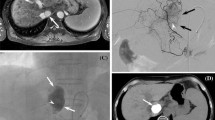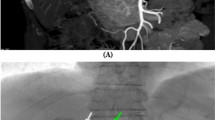Abstract
Purpose
To evaluate the incidence of each extrahepatic collateral pathway to hepatocellular carcinoma (HCC) and to assess technical success rates and complications of transcatheter arterial chemoembolization (TACE) through each collateral.
Methods
We retrospective evaluated extrahepatic collateral pathways to HCC on angiography in 386 procedures on 181 consecutive patients. One hundred and seventy patients had previously undergone TACE. TACE through extrahepatic collaterals using iodized oil and gelatin sponge particles was performed when a catheter was advanced into the tumor-feeding branch to avoid nontarget embolization.
Results
A single collateral was revealed in 275 TACE procedures, two were revealed in 74, and three or more were revealed in 34. Incidences of collateral source to HCC were 83% from the right inferior phrenic artery (IPA), 24% from the cystic artery, 13% from the omental artery, 12% from the right renal capsular artery (RCA) and left IPA, 8% from the right internal mammary artery (IMA) and right intercostal artery (ICA), and 7% from the right inferior adrenal artery (IAA). Technical success rates of TACE were 53% in the right ICA, 70% in the cystic artery, 74% in the omental artery, 93% in the left IPA, 96% in the right IPA, and 100% in the right RCA, right IMA, and right IAA. Complications included skin necrosis after TACE through the right IMA (n = 1), cholecystitis after TACE through the cystic artery (n = 1), and ulcer formation after TACE through the right gastric artery (n = 1), in addition to pleural effusion and basal atelectasis after TACE through the IPA and IMA.
Conclusion
Our study suggests that TACE through extrahepatic collaterals is possible with high success rates, and is also relatively safe.







Similar content being viewed by others
References
Dodd GD III, Soulen MC, Kane RA, et al. (2000) Minimally invasive treatment of malignant hepatic tumors: At the threshold of a major breakthrough. Radiographics 20:9–27
Yamada Y, Sato M, Kawabata M, et al. (1983) Hepatic artery embolization in 120 patients with unresectable hepatoma. Radiology 148:397–401
Uchida H, Ohishi H, Matsuo N, et al. (1990) Transcatheter hepatic segmental arterial embolization using lipiodol mixed with an anticancer drug and Gelfoam particles for hepatocellular carcinoma. Cardiovasc Intervent Radiol 13:140–145
Matsui O, Kadoya M, Yoshikawa J, et al. (1993) Small hepatocellular carcinoma: Treatment with subsegmental transcatheter arterial embolization. Radiology 188:79–83
Charnsangavej C, Chuang VP, Wallace S, et al. (1982) Angiographic classification of hepatic arterial collaterals. Radiology 144:485–494
Michels NA (1953) Collateral arterial pathways to the liver after ligation of the hepatic artery and removal of the celiac axis. Cancer 6:708–724
Koehler RE, Korobkin M, Lewis F (1975) Arteriographic demonstration of collateral arterial supply to the liver after hepatic artery ligation. Radiology 117:49–54
Miyayama S, Matsui O, Akakura Y, et al. (2001) Hepatocellular carcinoma with blood supply from omental branches: Treatment with transcatheter arterial embolization. J Vasc Interv Radiol 12:1285–1290
Chung JW, Park JH, Han JK, et al. (1998) Transcatheter oily chemoembolization of the inferior phrenic artery in hepatocellular carcinoma: The safety and potential therapeutic role. J Vasc Interv Radiol 9:495–500
Hirota S, Matsumoto S, Fukuda T, et al. (1999) Solitary hepatocellular carcinoma fed by the cystic artery: Limitation of transcatheter arterial embolization. Cardiovasc Intervent Radiol 22:206–209
Tanigawa N, Sawada S, Okuda Y, et al. (1998) A case of small hepatocellular carcinoma supplied by the cystic artery. AJR Am J Roentgenol 170:675–676
Park S II, Lee DY, Won JY, et al. (2003) Extrahepatic collateral supply of hepatocellular carcinoma by the intercostal arteries. J Vasc Interv Radiol 14:461–468
Soo CS, Chuang VP, Wallace S, et al. (1983) Treatment of hepatic neoplasm through extrahepatic collaterals. Radiology 147:45–49
Kim JH, Chung JW, Han JK, et al. (1995) Transcatheter arterial embolization of the internal mammary artery in hepatocellular carcinoma. J Vasc Interv Radiol 6:71–77
Duprat G, Charnsangavej C, Wallace S, et al. (1988) Inferior phrenic artery embolization in the treatment of hepatic neoplasms. Acta Radiol 29:427–429
Nakai M, Sato M, Kawai N, et al. (2001) Hepatocellular carcinoma: Involvement of the internal mammary artery. Radiology 219:147–152
Kodama Y, Shimizu T, Endo H, et al. (2002) Spontaneous rupture of hepatocellular carcinoma supplied by the right renal capsular artery treated by transcatheter arterial embolization. Cardiovasc Intervent Radiol 25:137–140
Miyayama S, Matsui O, Nishida H, et al. (2003) Transcatheter arterial chemoembolization for unresectable hepatocellular carcinoma fed by the cystic artery. J Vasc Interv Radiol 14:1155–1161
Miyayama S, Matsui O, Taki K, et al. (2004) Transcatheter arterial chemoembolization for hepatocellular carcinoma fed by the reconstructed inferior phrenic artery: Anatomical and technical analysis. J Vasc Interv Radiol15:815–823
Miyayama S, Matsui O, Akakura Y, et al. (2001) Use of a catheter with a large side hole for selective catheterization of the inferior phrenic artery. J Vasc Interv Radiol 12:497–499
Miyayama S, Matsui O, Taki K, et al. (2004) Combined use of an occlusion balloon catheter and a microcatheter for embolization of the unselectable right inferior phrenic artery supplying hepatocellular carcinoma. Cardiovasc Intervent Radiol 27:667–681
Komatsu T, Matsui O, Kadoya M, et al. (1999) Cystic artery origin of the segment V hepatic artery. Cardiovasc Intervent Radiol 22:165–167
Tajima T, Honda H, Kroiwa T, et al. (2002) Pulmonary complications after hepatic artery chemoembolization or infusion via the inferior phrenic artery for primary liver cancer. J Vasc Interv Radiol 13:893–900
Chung JW, Park JH, Han JK, et al. (1996) Hepatic tumors: Predisposing factors for complications of transcatheter oily chemoembolization. Radiology 198:33–40
Arora R, Soulen MC, Haskal ZJ (1999) Cutaneous complications of hepatic chemoembolization via extrahepatic collaterals. J Vasc Interv Radiol 10:1351–1356
Takayasu K, Moriyama N, Muramatsu Y, et al. (1985) Gallbladder infarction after hepatic artery embolization. AJR Am J Roentgenol 144:135–138
Takeuchi Y, Arai Y, Inaba Y, et al. (1998). Extrahepatic arterial supply to the liver: Observation with a unified CT and angiography system during temporary balloon occlusion of the proper hepatic artery. Radiology 209:121–128
Ishijima H, Koyama Y, Aoki J, et al. (1999) Use of a combined CT-angiography system for demonstration of correlative anatomy during embolotherapy for hepatocellular carcinoma. J Vasc Interv Radiol 10:811–815
Takayasu K, Muramatsu Y, Maeda T, et al. (2001) Targeted transarterial oily chemoembolization for small foci of hepatocellular carcinoma using a unified helical CT and angiography system: Analysis of factors affecting local recurrence and survival rates. AJR Am J Roentgenol 176:681–688
Author information
Authors and Affiliations
Corresponding author
Rights and permissions
About this article
Cite this article
Miyayama, S., Matsui, O., Taki, K. et al. Extrahepatic Blood Supply to Hepatocellular Carcinoma: Angiographic Demonstration and Transcatheter Arterial Chemoembolization. Cardiovasc Intervent Radiol 29, 39–48 (2006). https://doi.org/10.1007/s00270-004-0287-y
Published:
Issue Date:
DOI: https://doi.org/10.1007/s00270-004-0287-y




